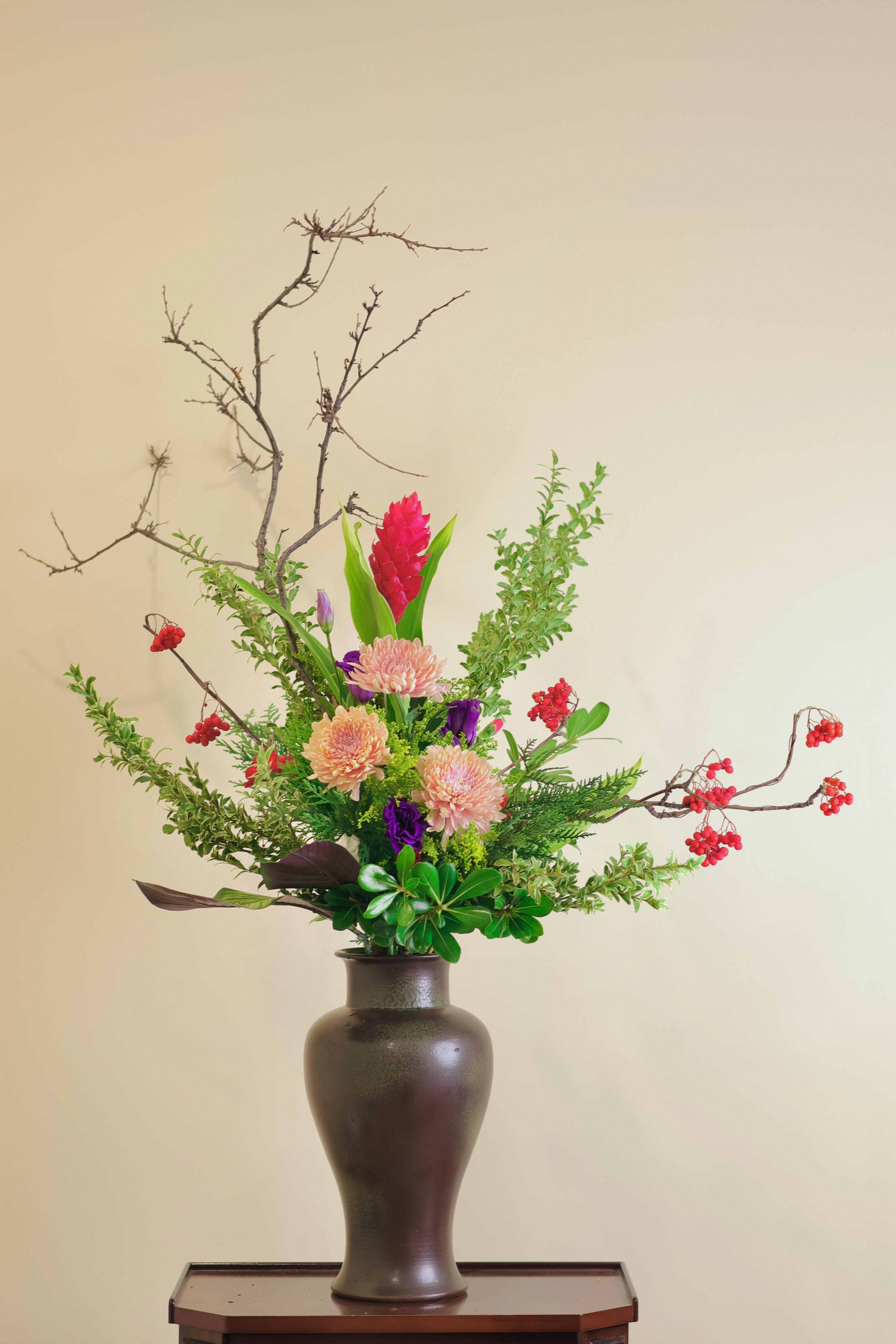The Origins and Evolution of Chinese Floral Art
中华花艺的起源与演变
In This Article

The Origins of Chinese Floral Art

The origins of Chinese floral art trace back over 1,500 years to the Wei, Jin, and Northern and Southern Dynasties, during which flowers were offered as part of Buddhist rituals. It is one of China's significant classical arts. At the time, floral arrangements were used for festive celebrations and religious offerings. Floral art could be seen in palace settings and on the desks of scholars. Its popularity grew from the royal courts to religious spaces and then to the general populace. People even established Flower Festival Day on the 15th day of the second lunar month to celebrate the "birthday of all flowers," making it the second most important festival of the time.
By the Tang and Song Dynasties, this art form, along with incense burning, tea brewing, and calligraphy, was regarded as one of the "Four Arts of Life." It became a fundamental and widespread skill of daily life. Unfortunately, by the late Qing Dynasty and early Republican era, due to wars and hardships, the art of floral arrangement gradually declined, becoming almost entirely unfamiliar to the general public.
Revival of Chinese Floral Art
In 1983, during a Japanese Ikebana workshop hosted by the Chinese Women's Orchid Association in Taiwan, participants were astonished when the instructor revealed that Japanese Ikebana had its roots in Chinese floral art. This revelation inspired a group of enthusiasts, led by Professor Huang Yongchuan, to research and revive the rich history of Chinese floral art. In 1984, they held the first Chinese Classical Floral Art Exhibition at Taiwan's National Museum of History, marking the first such exhibition since the Tang and Song Dynasties.
Driven by a sense of cultural responsibility, Professor Huang Yongchuan established the Chinese Floral Art Cultural and Educational Foundation in 1986. With a group of dedicated teachers, he developed a structured theoretical and technical system for teaching Chinese floral art, thus laying the foundation for its revival.
The Chinese Floral Art Education System
The cultivation of a floral artist, much like the blooming of a flower, requires time. The learning process is divided into levels:
- Lectures
- Beginner
- Intermediate
- Advanced
- Research Levels 1, 2, and 3
- Senior Research
The entire training process takes about seven years. To become a certified Chinese floral art instructor, students must pass an examination after completing the advanced course and then undertake teacher training courses in the research class.
Characteristics of Chinese Floral Arrangements
Chinese floral art is an art of spatial positioning. The arrangement's orientation and proportions are based on principles derived from the Hetu and Luoshu diagrams (ancient Chinese cosmological charts). Floral vessels are categorized into six types: vases, plates, jars, bowls, tubes, and baskets.
Based on the creator's intent and subject matter, Chinese floral arrangements can be divided into four types:
- Scenic Flowers - Depicting landscapes
- Conceptual Flowers - Conveying ideas
- Imaginary Flowers - Expressing emotions or abstract thoughts
- Sculptural Flowers - Focusing on form and structure
The framework of an arrangement is built around three main branches:
- Shi Stem (the flower's mission)
- Ke Stem (the flower's companion)
- Zhu Stem (the flower's leader)

中华花艺起源
中华花艺缘起于一千五百多年前魏晋南北朝的佛教供花。是中国重要的古典艺术之一。当时的插花,被应用到节日庆典和宗教供养上。在宫廷摆设,文人案头,都可以见到插花艺术。从宫廷到宗教,到民间,插花风气大盛起来。人们甚至把农历二月十五定为花朝节(百花生日)大肆庆祝,这个节日当时就成为了国家第二个重要的节日。
到了唐宋时代,这种艺术修养与"焚香"、"点茶"、"挂画",同称为生活四艺。成为了当时人们最基本,最普遍的生活素养。可惜清末明初,由于战乱,民生疾苦,插花艺术因而日趋没落。插花艺术对于国人而言,到了几乎是完全陌生的地步。
1983年,中国台湾中华妇女兰艺社,在一次日本花道老师的插花教学活动中,震惊于老师所说:日本花道缘起于中国插花。因而有感于中国插花之光荣历史,有积极发扬光大的必要。便结合黄永川教授及一群同好者,潜心研究。1984年在台湾国立历史博物馆举办了第一届"中国古典插花艺术展。是自唐宋以来首届纯中国传统插花艺术展。
受文化意识的驱使,黄永川教授肩负民族使命感,于1986年成立了财团法人中华花艺文教基金会。带领一群热爱中华花艺的老师,一起建构中华文化的轨道,创立了中华花艺系统教学的理论以及技术体系。
中华花艺教学体系一朵花开需要时间,一位花艺家的养成更需要时间。中华花艺的学习分为:讲座、初级、中级、高级、研一、研二、研三、高研。学习时长为七年。若想要教授中华花艺,成为中华花艺的老师,则需要在高级课程完成后考试,取得高级证书之后可以进修研究班师资课程。
中华花艺的插作中华花艺是方位艺术,插作的方位、比例是根据河图洛书来应用变化的。花器主要分为六大器型:瓶、盘、缸、碗、筒、篮。就创作者的心态与内容来区分的话,中华花艺分为四大类型:写景花、理念花、心象花和造型花。花型的骨架主要由三大主枝构成:主枝(花盟主),客枝(花客卿),使枝(花使命)。就插作的花型来区分,分为六大基本花型:直立型、倾斜型、平出型、倒挂型、平铺型、综合型。在色彩运用上,中华花艺的色彩观念衍生于中国的阴阳五行学说,以五大正色为正宗,阴阳配为大吉。

 By Melody Zhang
By Melody Zhang